Creating Connections: How Libraries Can Use Exhibits to Welcome New Students
In Brief:
Feelings of loneliness are common among first-year college students during the start of the academic year. Academic and social integration into the campus community—both factors that can positively affect student retention—are critical yet difficult for any one group to manage. Grand Valley State University Libraries expanded its reach to help foster student engagement through an immersive, multifaceted exhibit showcasing personal stories of students through illustrations and audio recordings. Participants also had an opportunity to contribute to a mural. The exhibit, which ran for the first six weeks of the fall semester, provided students with novel ways to connect and identify with their peers. We will highlight an innovative approach to cultivating student belonging and detail how an exhibit can strengthen the library’s institutional relevance.
by Emily Frigo, Emily Fisher, Gayle Schaub, and Cara Cadena
The Experience
You’re a college freshman living away from home for the first time. You don’t know many people. It’s the week before school, and you’ve been through several campus orientations. You decide to go to the library with your laptop, get a cup of coffee, and plan your first week. On the way in, you pass a glass-enclosed gallery and see a large mural of colored dots. Text on the door reads, “Connected: An Exhibit of Shared Laker Experiences.” Curious, you decide to check it out.
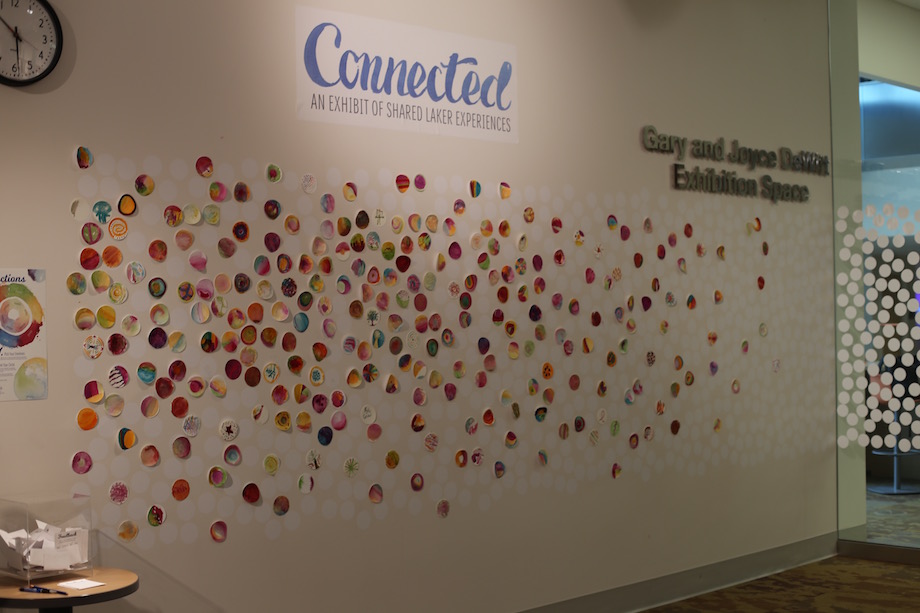
Copyright Grand Valley State University, 2016
Upon entering you see a poster which reads, “We’re all human. We all have stories. In an increasingly noisy world, we may not always truly hear each other. Through shared stories, we can find connections, find community, and find ourselves.” Watercolor portraits of eight current students hang on the walls. You read quotes from these students and learn something personal about each one. Matthew, an international student, shares that it’s been difficult learning to cook for himself. “I usually just eat cereal,” his story explains. Another student mentions how her relationship with her mother has improved since she moved away from home. Each anecdote is vastly different from the next, but they all read as authentic. The emotive power of watercolor brings each person to life in a unique way.
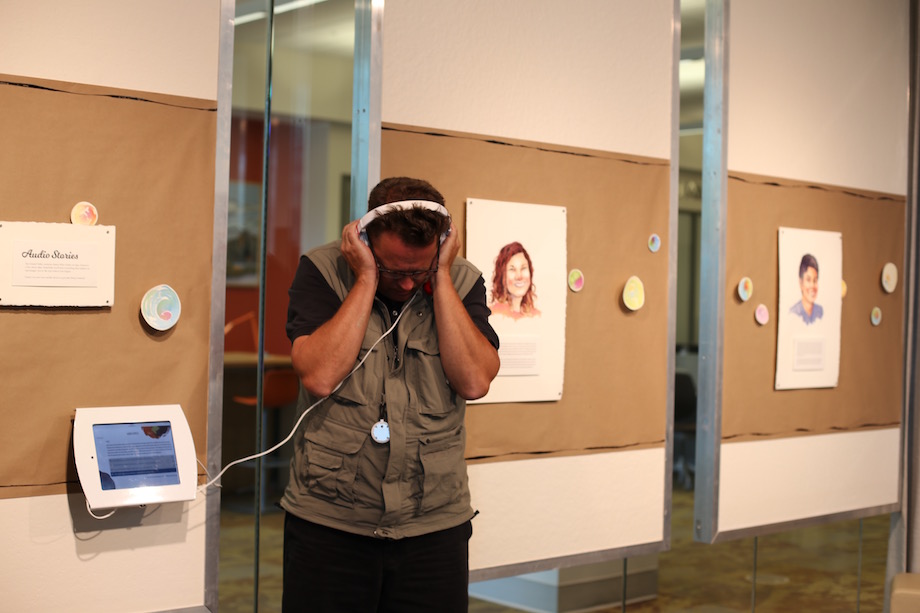
Copyright Grand Valley State University, 2016
Then you see two iPads mounted on the wall, each with a set of headphones asking if you’d like to hear stories from more Grand Valley State University students. You put on the headphones and meet Elyse, 28, who just finished her first year at GVSU. After dropping out of high school and taking classes at a local community college in her early twenties, Elyse looks at education differently than she once did. She is a highly motivated, successful student who, after graduating, plans to pursue a master’s degree in journalism and someday ride a motorbike through Vietnam.
Next you listen to Vanessa’s story. She graduated in 2017 with a degree in allied health sciences and a minor in criminal justice. She plans to pursue a master’s degree in public health. Growing up bilingual in a small town made Vanessa’s transition to GVSU a bit of a challenge at first. Seeking out (and receiving) grants, getting involved with student support services, and being her own strongest advocate, Vanessa has become an amazing example for others on how to succeed at college, no matter what your background.
Through each of these stories, you start to realize that GVSU is more than just 25,000 students; it’s 25,000 individuals who also didn’t know what they were doing when they were freshmen, but who persisted, asked questions, and eventually met goals they didn’t realize they had.
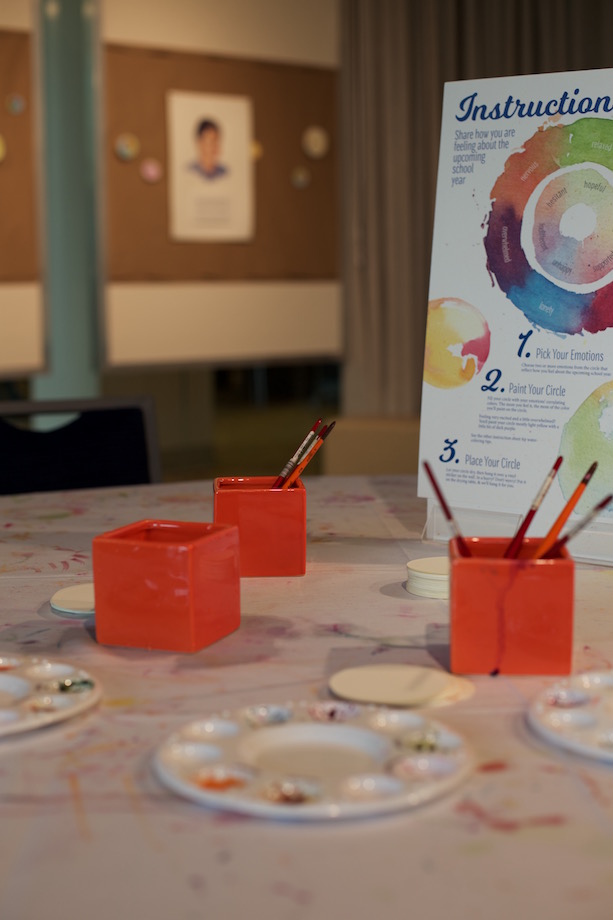
Copyright Grand Valley State University, 2016
You hang up the headphones and find a large table inviting you to express how you’re feeling about the new school year by painting a white paper dot in watercolor. Tips for painting in watercolor and a color wheel of emotions sit upright on the table—nervous is orange, hopeful is light green. Ten other emotions span the wheel. You tape your dot to the collective mural. You notice that many others have filled their dots with similar colors, and you begin to feel less alone. You’ve made your mark on campus, one of many you will make, signaling the beginning of your college experience.
Introduction
“Connected: An Exhibit of Shared Laker Experiences” was deliberately designed to support students at a key transition point—the start of the school year—by fostering social engagement and cultivating a sense of belonging, both of which can ease their acclimatization to college. ((Tinto, 1975; 2010)) The exhibit, designed and curated by Erin Fisher, Gayle Schaub, Cara Cadena, and Emily Frigo, signaled to students that the Mary Idema Pew Library Learning and Information Commons is full of dynamic and accessible spaces, all intended to help them thrive. It proved to be a novel and meaningful way to reinforce the University’s mission of supporting students. This article describes the exhibit itself and details the collaborative and participatory strategies used to engage visitors and build community through creative expression. While the exhibit has a student-centric focus, the design strategies and overarching philosophy can be adapted in all types of libraries.
Background & Rationale
Grand Valley State University (GVSU) is a comprehensive university committed to providing students with a broad-based liberal education. The University Libraries demonstrates its student-centered focus with continual study of space usage in its buildings, robust patron-driven acquisitions, a peer research consultant program, responsive web design, and a curricular-based library instruction program. Faculty and staff strive to identify and provide support for students at their points of need.
The Mary Idema Pew Library, which opened in 2013, exemplifies a student-centered focus through both form and function. It was designed based on research of student study habits, preferences, and needs. The physical spaces accommodate students’ desire for flexibility and comfort; the furniture is moveable, outlets are never more than a few feet away, ample natural light fills the space, and there is a wide range of seating options.
The building also includes dedicated spaces for events and exhibits in the hopes that students from all disciplines engage in moments of learning outside of the classroom. Library programming is also intended to enliven the atmosphere and signal that the library is a vibrant community gathering space. This includes the Gary and Joyce DeWitt Exhibition Space, the installation space for the Connected exhibit; it is centrally located and glass enclosed to encourage drop-in viewing. However, observations showed that few students visited the gallery outside of formally scheduled programming. Anecdotally, students have said they are unsure whether they are allowed in.
More broadly, some students and faculty report that the Mary Idema Pew Library can be an intimidating place. We wondered if library anxiety related to the building may be a factor inhibiting students from fully engaging with our spaces and thus our services. Libraries have long participated in orientation programs, summer bridge programs, and more, to raise awareness of the library and help students transition to college. Common across all these programs is the goal to create a positive experience with the library and thus help alleviate library anxiety. ((Jiao, 1997))
Erin, Library Program Manager, was searching for a creative and compelling way to show students that the gallery, like all other spaces in the library, belongs to them. Emily, First Year Initiatives Coordinator, wanted a unique way to welcome first-year students to campus and to the library.
Student Focus
The starting point of a student’s college journey is a crucial transition point for freshmen. Fisher and Hood’s assertion, the most frequently cited to date in the literature, is that homesickness sets in after the first couple of weeks of the term. ((1987; Thurber & Walton, 2012)) Feelings of ineptitude and isolation can negatively impact a student’s ability to succeed in college. ((Tinto, 1975; 2010)) According to the GVSU MapWorks ((MAP-Works is an online student retention tool administered by Skyfactor.)) 2013 and 2014 survey results, ((Batty, 2014; GVSU Office of Institutional Analysis, 2013)) Grand Valley students tend to score lower than students from peer institutions in the areas of academic and social integration, both factors that can impact student retention. ((Tinto, 1975; 2010)) Engaging with peers is integral to a student’s successful transition. ((Kuh et al., 2006)) A participatory exhibit was an innovative way for students to connect with their peers and help normalize the emotions that accompany the start of the school year.
While GVSU has a robust library instruction program and information literacy is integrated into the General Education curriculum, it does not have a First Year Experience (FYE) program. Without a FYE program, support services are distributed across the Division of Student and Academic Affairs, making it challenging for GVSU Libraries to collaborate and integrate on campus. One of the goals of the exhibit was to raise awareness of the library’s support services among other campus units. To see the true value of the library, the campus community needed to see beyond the beautiful, light-filled building to appreciate the staff and services that undergird it.
Exhibit Execution
In August 2015, Erin and Emily’s outreach efforts manifested in an exhibit titled “Letters for Lakers.” The exhibit encouraged visitors to take a letter, leave a letter, send a letter. Approximately 50 unique letters containing encouraging messages, reflections, and memories related to the college experience were written by GVSU faculty, students, and staff. These letters were reproduced to fill 300 or so envelopes that hung on the gallery walls. In total, 220 letters were taken. Mailboxes were set up and blank letterhead sat on a table for students to write letters to their future selves. 165 students participated in this activity. All 1,000 postcards printed were taken. Student visitors were also encouraged to use sticky notes to leave encouraging messages for one another. 183 sticky notes were contributed. Student participation with the exhibit exceeded expectations, so plans were made to create a subsequent exhibit in 2016.
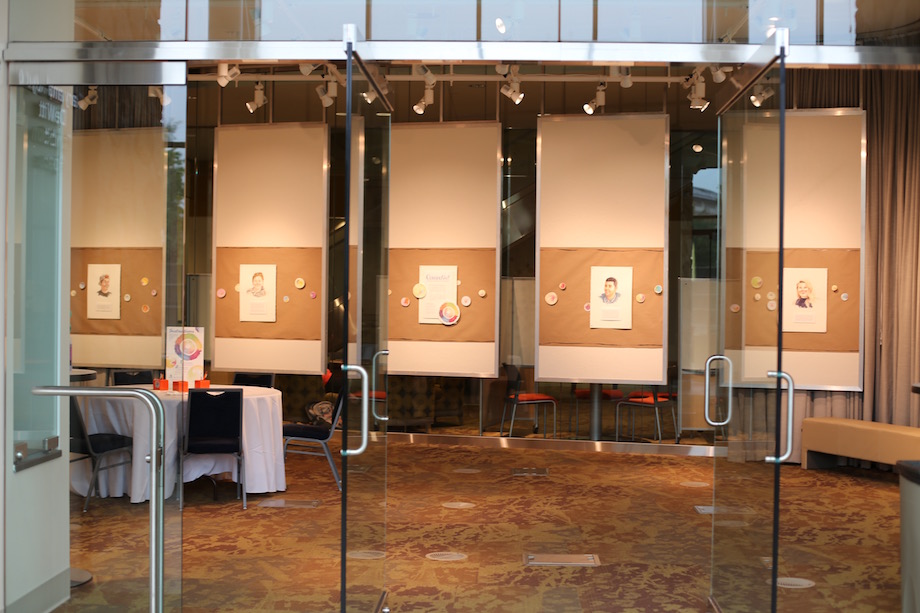
Copyright Grand Valley State University, 2016
Colleagues Cara Cadena and Gayle Schaub, Liaison Librarians, joined Erin and Emily to form a working group in January 2016. Cara brought a needed and different perspective working with professional programs on our downtown campus; Gayle was invited because of her outreach efforts and her passion for supporting students. The group met several times to brainstorm ideas. We considered the space constraints, costs, technical expertise, and other elements while keeping in mind the stated goals:
- Entice students to enter and explore the exhibition space to signal to them that they can take ownership of the space.
- Invite students to join each other in collective expression through a participatory element.
- Generate a sense of welcoming to assuage feelings of homesickness.
- Signal to students that the library is a safe and welcoming space where students’ voices are heard and valued.
Together, we decided that the 2016 exhibit would include student stories paired with watercolor portraits and audio stories. Through stories, we hoped to illustrate that no one is alone in their trepidation, happiness, and exasperation, and that the campus community works collaboratively to welcome and support them. A participatory component where visitors could directly contribute would also be included. The exhibit was inspired by many different creative influences, most notably the Oak Park Public Library’s Idea Box, Humans of New York, Wendy MacNaughton, Damien Hirst, and StoryCorps.
Watercolor Portraits
In 2014, a dedicated group of GVSU students began taking photographs and gathering stories from fellow students in the style of the widely popular project Humans of New York, which pairs photographs of everyday people with person-on-the-street interviews. We approached Humans of Grand Valley (HoGV) as collaborators on this project because this style is one imbued with an overwhelming sense of authenticity. The student group gathered a special collection of stories specifically for the exhibit. Of the twenty stories they collected, eight were selected for display, chosen to represent a range of experiences and connect with our diverse student body.
We approached art and design students to find an artist to create the watercolor portraits. Alumna Ellie Lubbers was hired to create original illustrations of students based on photographs taken by HoGV. This resulted in eight stunning watercolor illustrations. Below each portrait was an excerpt from the full-length interview conducted by HoGV.
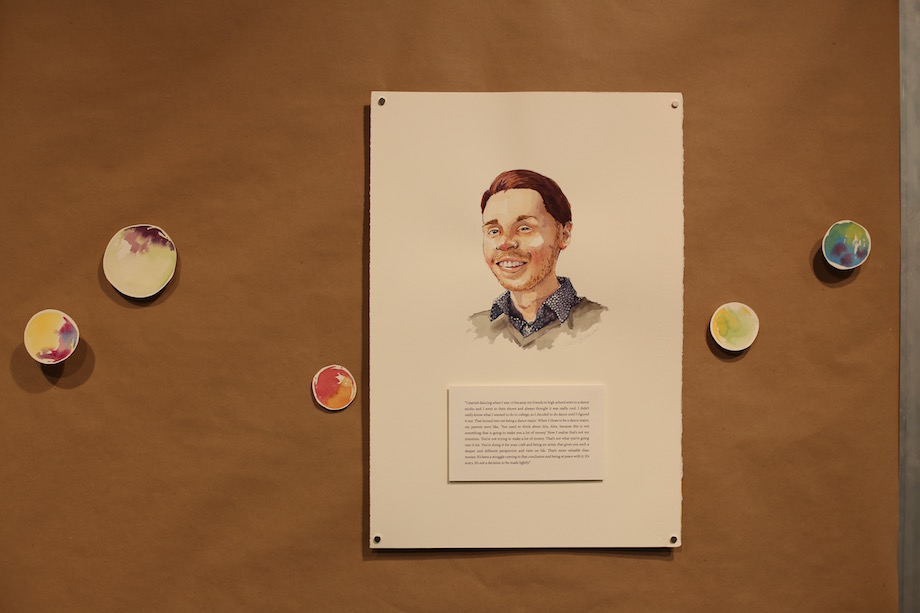
Copyright Grand Valley State University, 2016
Ellie had been a resident assistant in the campus dorms. Her skills were paramount in making our vision truly come to life. She assisted with the overall exhibit design and installation, was instrumental in shaping the participatory component, and created promotional materials. Ellie also provided other critical feedback on how we could best reach students to accomplish the stated goals.
Audio Stories
The impetus behind the collection of audio stories was the desire to make the exhibit as inclusive as possible, not just its content but also the modes of interaction with the content. The inclusion of recorded stories, separate from any visual representation, added another dimension to the peer-to-peer interactive nature of the exhibit. Audio stories were longer, more in-depth than the stories that accompanied the watercolors. The stories are digitally archived, with transcripts, keeping them accessible long after the exhibit’s run.
As avid listeners of the weekly broadcasts of StoryCorps, heard on National Public Radio’s Morning Edition, we understood the power of stories to inspire, unite, and comfort. In fact, StoryCorps’s mission expressed perfectly one of our primary goals: “…to remind one another of our shared humanity, to strengthen and build the connections between people, to teach the value of listening, and to weave into the fabric of our culture the understanding that everyone’s story matters.” ((StoryCorps, 2017)) Students narrating their stories for others to hear was an intriguing addition to the primarily visual exhibits visitors had experienced thus far in the library.
To solicit a wide variety of stories, we reached out to the directors, organizers, and faculty advisors of groups at GVSU that offer support, resources, and guidance to students of various backgrounds with differing needs. The invitation to participate didn’t make any specific demands; students were simply asked if they’d be willing to tell a story or two about their experiences at GVSU.
We received responses from a number of student organizations representing students of varying ages and from a spectrum of gender, social, economic, and cultural backgrounds. Ten students shared their stories. The original, full-length recordings were transcribed and then edited into shorter sound bites for the online collection used in the exhibit. For most of the students, it was the only time they had been offered the chance to talk at length about themselves, to articulate their unique educational challenges and successes, and to be truly heard. For those who participated, the process of storytelling was as important as the stories themselves. ((Audio stories featured students from: WISE (Women in Science and Engineering); TRIO Student Support Services, a federally-funded support program for first-generation and limited-income students; GVSU Crew (club sport); GVSU Veterans Network; Milton E. Ford Lesbian, Gay, Bisexual & Transgender (LGBT) Resource Center; Padnos International Center; DeVos Center for Entrepreneurship and Innovation.))
One student’s recording session included a highly emotional recounting of a racially charged conversation with a professor. Afterward, she recognized aloud that not only had she not intended to tell that particular story, she felt an extraordinary sense of relief and empowerment at having done so. In telling her story, she realized her experiences shaped who she was, helped her find strength, affected her career choices, and defined her self-worth. Another participant, a returning veteran student, military wife, and pregnant mother of a toddler, found the storytelling process unexpectedly cathartic. As she spoke, she came to terms with the incredible amount of work and stress she faced, breaking down more than once. For all ten participants, the exhibit creation process gave as much or more to them as it did to the visitors.
Participatory Mural
Approximately 900 cut circles of white vinyl stickers were affixed to a wall of the gallery to create the canvas for the temporary, participatory mural. Corresponding three-inch circles cut from watercolor paper sat on a nearby table along with paint, brushes, water, and instructions for the activity. A color wheel detailing a range of emotions was prominently displayed to guide visitors in creating a watercolor dot that was unique to their experience. Watercolor was an ideal medium for representing emotions and it provided a low-threshold way for anyone, no matter their artistic ability, to participate.
The Value of Arts Programming
The exhibit provided visitors with a visual, auditory, and tactile experience that was multivocal and interactive. No other means would have provided such capabilities; art historian Mark Getlein explains that artmaking has the power to “Create places for some human purpose; create extraordinary versions of ordinary objects; give tangible form to the unknown; give tangible form to feelings and ideas; and refresh our vision to help us see the world in new ways.” ((2008, pp. 7-10)) The non-prescriptive nature of art also means that individuals can interpret work based on their own unique experiences. Through art, we created an accessible space where students could connect with their peers, the library, and the University at large in a novel way.
Participatory Techniques
The exhibit’s participatory artmaking element deepened students’ experience by allowing them to not only consume its content but contribute to it as well. We were first introduced to the concept of participatory exhibits through the work of Nina Simon, author of The Participatory Museum. In the book, Simon explains that participation enables visitors to “create, share and connect with each other around content.” ((Simon, 2010, p. ii)) The techniques popularized by Simon have been widely adopted by museums, libraries, and other cultural institutions as a way to more actively engage visitors while still honoring the mission, vision, and values of an institution. Claire Bishop writes about participation in the realm of contemporary art in the book Participation. In the introduction, she lists three reasons why artists typically employ participatory techniques: they give the audience agency; they are less hierarchical than other modes of artistic production; and they create social bonds through collective expression. ((Bishop, 2010))
The Mary Idema Pew Library strives to create a learning environment that “supports the whole student through the academic journey.” ((Makowski, 2016, in an interview with retired Dean of University Libraries Lee Van Orsdel)) Participatory exhibits are an exemplary way to build students’ affinity for the library. We believe they lead to deeper engagement with our spaces and services, while also allowing students to make connections with their peers. Social connections are critical to students’ overall success. Alexander Astin states that “peers are the single most potent source of influence,” affecting virtually every aspect of their development. ((1993, p. 398; Kuh et al, 2006)) Our exhibit goes far beyond traditional library orientations by acknowledging that social needs are equally as important as academic, and does so at a crucial time in their college journey. Even more, exhibits like “Connected” give students the opportunity to actively engage in creative expression, a key tenet of a liberal arts education.
Exhibit Evaluation
Libraries of all types still struggle to find the appropriate means to evaluate cultural programming. ((Fraser, et al., 2014)) With each new exhibit, we consider new or revised ways to measure reach and impact more concretely. Our quantitative evidence is sparse but the qualitative evidence gathered suggests that the exhibit accomplished its intended goals.
We do not know how many people in total attended the exhibit because the space does not include sensors to count visitors. Our target audience comprised 4,380 first-time students. Almost 300 dots were painted as part of the participatory mural. Although attendance numbers do not directly correlate with value, the metric would be helpful to evaluate reach.
A small table near the mural wall included a comment box and slips of paper with a prompt asking students to “Tell us what element(s) of the exhibit you connected with most.” Feedback was uniformly positive. We received 60 responses, including the following statements:
- “I loved that we can connect with the community with art, colors, and how we feel.”
- “I connected with a few of the stories. I love how there is always someone out there feeling the same emotions.”
- “So good! I never thought so many other students were as nervous all the time as I was.”
- “Awesome! I enjoyed listening & reading others’ stories. I can relate.”
- “This was a beautiful opportunity! I loved being able to be creative which is something I don’t get to do often!”
- “Thank you so much for bringing this here. It was a great outlet to silently release my emotions creatively.”
Conclusion
Our organization supports a culture of innovation and informed risk-taking, which allows us to try new methods of engaging and supporting our students. The exhibit is a good example of that culture in action. Conceptualizing and designing a project of this scope and magnitude was not easy, yet creating spaces for discovery is worth doing. Like many art exhibits, ours was designed to elicit contemplation and creativity; we wanted visitors to listen and learn. Student stories were honest and insightful. The stories, the portraits, and the wall of emotions were intended to make visitors feel more connected to a place (Grand Valley) they would call home for the next several years, and a space (the library) where they would spend a lot of their time. They also reminded us, the exhibit organizers, that everyone has their own set of difficulties and triumphs.
The components of the exhibit were unique to GVSU. Your participatory exhibit will be unique to your library community, but the message will be the same: the library is a place where stories matter and individual voices are heard.
Acknowledgements: Thank you to our internal reviewer, Bethany Messersmith; our external reviewer, Jamie Vander Broek; and publishing editor, Amy Koester. “Connected: An Exhibit of Shared Laker Experiences” was created in collaboration with Humans of Grand Valley, especially Jaclyn Ermoyan. Grand Valley alumna Ellie Lubbers created original artwork for the exhibit. Thank you to Len O’Kelly Ph.D., who patiently edited the audio files for exhibit and archiving. Our gratitude to Matthew Reidsma for wrangling the website for the audio stories. Endless thanks to the students whose stories were featured in the exhibit.
References
Astin, A. W. (1993). What matters in college?: Four critical years revisited. San Francisco: Jossey-Bass.
Batty, P. (2014). MAP-Works executive summary. Retrieved from http://www.gvsu.edu/cms4/asset/DD2DE79E-BC8A-0755-18696BC35286807F/map-works_exec_summary_2014.pdf
Bishop, C. (2010). Participation. London: Whitechapel.
Fisher, S., & Hood, B. (1987). The stress of the transition to university: A longitudinal study of psychological disturbance, absent-mindedness and vulnerability to homesickness. British Journal Of Psychology, 78(4), 425.
Fraser, J., Sheppard, B., & Norlander, R. J. (2014). National Impact of the Library Public Programs Assessment (NILPPA): Meta-Analysis of the American Library Association Public Programs Office Archives. (NewKnowledge Publication #IMLS.74.83.02). New York: New Knowledge Organization Ltd.
Getlein, M. (2008). Living with art. New York: McGraw-Hill Higher Education.
GVSU Office of Institutional Analysis. (2013). Results from the MAP-Works survey of first-year undergraduates. Retrieved from http://reports.ia.gvsu.edu/mw2013/MAP-Works_firstyear_2013_report_031114b.pdf
Jiao, Q., & Onwuegbuzie, A. (1997). Antecedents of library anxiety. The Library Quarterly: Information, Community, Policy, 67(4), 372-389. Retrieved from http://www.jstor.org/stable/40039590
Kuh, G., Kinzie, J., Buckley, J., Bridges, B., & Hayek, J. (2006). What Matters to Students Success: A Review of the Literature. Commissioned Report for the National Symposium on Post-Secondary Student Success: Spearheading a Dialog on Student Success. National Postsecondary Education Cooperative (NPEC).
Makowski, M. (2016). Mary Idema Pew Library named landmark library. GV Now. Retrieved from https://www.gvsu.edu/gvnow/2016/mary-idema-pew-library-named-landmark-library-9603.htm
Simon, N. (2010). The Participatory Museum. Santa Cruz, Calif: Museum 2.0.
Stanton, B. (2017). Humans of New York. Retrieved from http://www.humansofnewyork.com/
StoryCorps. (2017). Mission statement. Retrieved from https://storycorps.org/
Thompson, N. (2015). Seeing Power: Art and Activism in the 21st Century. Brooklyn, N.Y: Melville House.
Thurber, C. A., & Walton, E. A. (2012). Homesickness and adjustment in university students. Journal of American College Health, 60(5), 415-419.
Tinto, V. (1975). Dropout from higher education: A theoretical synthesis of recent research. Review of Educational Research 45(1) 89–125. Retrieved from www.jstor.org/stable/1170024
Tinto, V. (2010). From theory to action: Exploring the institutional conditions for student retention. In J.C. Smart (Ed.), Higher Education: Handbook of Theory and Research, Vol. 25 (pp. 51-90). DOI:10.1007/978-90-481-8598-6_2

Hello
Really loved this idea of the connected wall/exhibition. I am a part -time library assistant in a Healthcare Library run by Queen’s University, Belfast, which is for University Students and Healthcare professionals. Before my present job I was a textile designer and so I appreciate this as a piece of art but love the idea of the interactive function helping the Students settle into University Life. I also am a Mum and left my daughter to University in England. I think knowing that there is somewhere to go and just read and hear
from others that have had the same problems and your not on your own. It would be comforting to know.
Pingback : Thing 3.5 – Library Blogs – Liminal Librarian